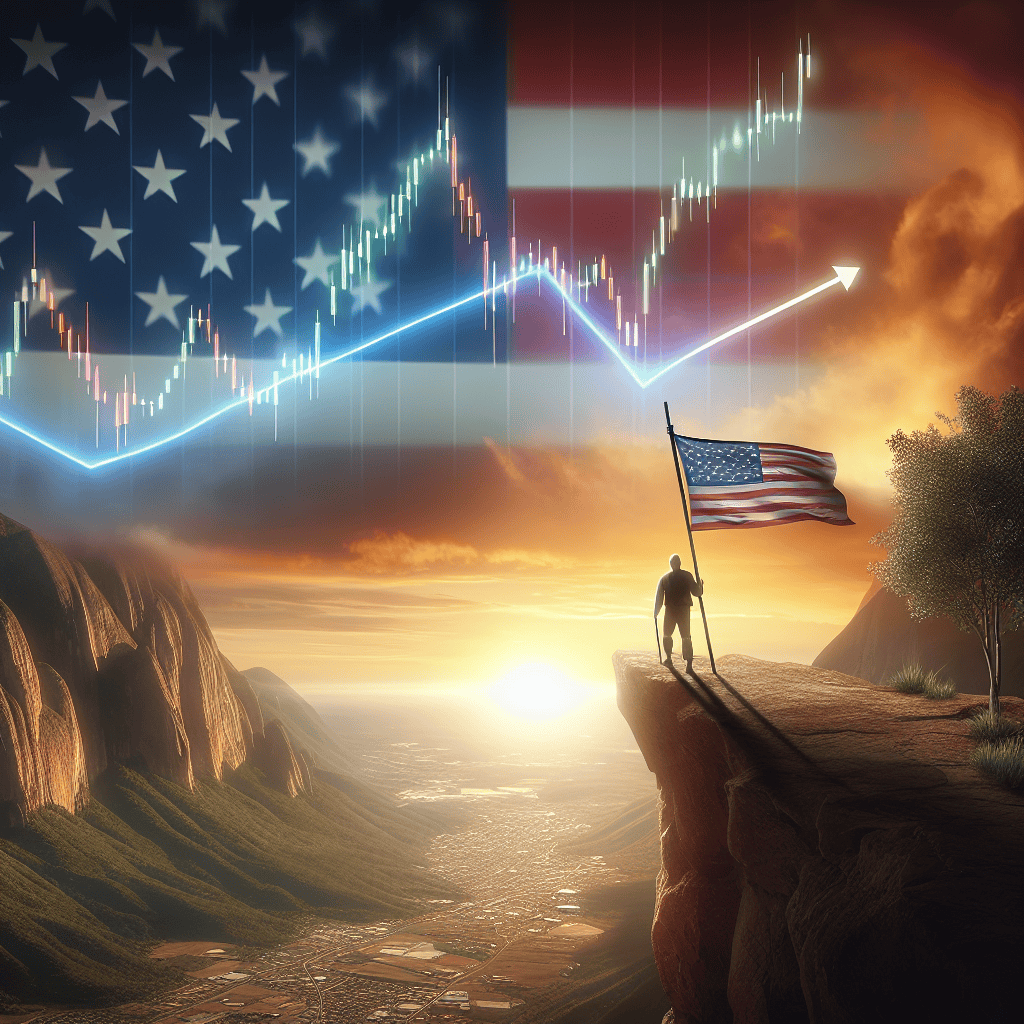“US Stock Futures Surge: Anticipation Builds as Presidential Election Looms”
Introduction
US stock futures experienced an upward trajectory as investors closely monitored developments leading up to the presidential election. This pre-election period has historically been marked by heightened market volatility, with traders and analysts keenly assessing potential policy shifts and economic implications tied to the election outcome. The climb in futures reflects a cautious optimism among market participants, who are weighing the prospects of fiscal stimulus measures, regulatory changes, and international trade policies that could be influenced by the election results. As the nation prepares to head to the polls, the financial markets are poised for significant movements, underscoring the critical intersection of politics and economics in shaping investor sentiment and market dynamics.
Impact Of Presidential Elections On US Stock Futures
As the United States approaches another pivotal presidential election, the financial markets are abuzz with anticipation, particularly the stock futures market. Historically, presidential elections have had a significant impact on stock futures, as investors attempt to predict the economic policies that will follow the election of a new leader. This year is no exception, with US stock futures climbing as investors weigh the potential outcomes and their implications for the economy.
The relationship between presidential elections and stock market performance is complex, influenced by a myriad of factors including political platforms, economic conditions, and investor sentiment. Typically, markets favor stability and predictability, and the uncertainty surrounding an election can lead to increased volatility. However, as the election date nears, investors often begin to position themselves based on their expectations of the election’s outcome and the anticipated policy directions of the candidates.
In the weeks leading up to the election, stock futures often reflect the prevailing sentiment in the market. For instance, if investors believe that a particular candidate’s policies will be beneficial for business, stock futures may rise in anticipation of a favorable economic environment. Conversely, if there is concern that a candidate’s policies could hinder economic growth, stock futures might experience downward pressure. This dynamic is evident in the current market, where stock futures have been climbing as investors digest the latest polling data and economic indicators.
Moreover, the impact of presidential elections on stock futures is not limited to domestic factors. Global economic conditions and geopolitical events also play a crucial role in shaping investor expectations. In an increasingly interconnected world, the policies of the US president can have far-reaching implications, influencing trade relations, regulatory environments, and international cooperation. As such, investors must consider both domestic and international factors when assessing the potential impact of an election on stock futures.
In addition to these considerations, historical trends provide valuable insights into how stock futures might behave in the context of a presidential election. Research indicates that stock markets tend to perform better in the year following an election, regardless of which party wins. This phenomenon, often referred to as the “presidential election cycle theory,” suggests that markets may rally as uncertainty dissipates and investors gain clarity on the future policy landscape. However, it is important to note that past performance is not always indicative of future results, and each election cycle presents its own unique set of circumstances.
As the election draws closer, investors will continue to monitor a range of factors that could influence stock futures, including economic data releases, corporate earnings reports, and developments in key policy areas such as taxation, healthcare, and trade. Additionally, the potential for unexpected events, such as geopolitical tensions or natural disasters, adds another layer of complexity to the market’s response to the election.
In conclusion, the impact of presidential elections on US stock futures is multifaceted, shaped by a combination of political, economic, and global factors. As investors navigate this period of heightened uncertainty, they must remain vigilant and adaptable, ready to respond to new information and changing market conditions. While the outcome of the election will undoubtedly influence the direction of stock futures, the broader economic landscape and investor sentiment will ultimately determine the market’s trajectory in the months and years to come.
Historical Trends: Stock Futures During Election Years
As the United States approaches another presidential election, the financial markets are once again under the spotlight, with investors keenly observing the movements of stock futures. Historically, election years have been periods of heightened volatility and uncertainty in the markets, as investors attempt to anticipate the potential economic policies of the incoming administration. This year is no exception, with US stock futures climbing as the election date draws near. To understand the current market dynamics, it is essential to examine historical trends and how stock futures have behaved during previous election years.
Historically, the stock market has shown a tendency to react to the political climate, with stock futures often reflecting investor sentiment regarding the potential outcomes of the election. In general, markets prefer stability and predictability, and the uncertainty surrounding an election can lead to increased volatility. However, it is also important to note that the stock market is influenced by a myriad of factors, including economic indicators, corporate earnings, and global events, which can sometimes overshadow the impact of an election.
Looking back at past election years, a pattern emerges where stock futures often experience fluctuations in the months leading up to the election. For instance, during the 2008 presidential election, the financial crisis was a dominant factor, causing significant market turmoil. Despite the uncertainty, stock futures eventually stabilized as investors gained clarity on the economic policies of the incoming administration. Similarly, in the 2016 election, stock futures initially reacted negatively to the unexpected outcome but quickly rebounded as investors adjusted their expectations based on the new administration’s policy proposals.
Moreover, it is worth noting that the party affiliation of the winning candidate can also influence market behavior. Historically, markets have shown a tendency to perform better when there is a clear expectation of pro-business policies, often associated with Republican administrations. However, this is not a hard and fast rule, as Democratic administrations have also overseen periods of robust market performance. Ultimately, the market’s reaction is more closely tied to the specific policies and economic conditions rather than the party in power.
In the current election cycle, several factors are contributing to the positive movement in stock futures. Investors are closely monitoring the economic recovery from the COVID-19 pandemic, inflation trends, and the Federal Reserve’s monetary policy stance. Additionally, the potential for new fiscal policies, including infrastructure spending and tax reforms, is being weighed by market participants. As these factors interplay with the election dynamics, stock futures are likely to continue experiencing fluctuations.
In conclusion, while US stock futures are climbing ahead of the presidential election, it is crucial to consider the broader historical context and the multitude of factors influencing market behavior. Election years have traditionally been periods of uncertainty and volatility, but they also present opportunities for investors who can navigate the complexities of the market. By understanding historical trends and remaining informed about current economic conditions, investors can better position themselves to respond to the evolving landscape as the election unfolds. As always, maintaining a long-term perspective and a diversified portfolio remains a prudent strategy in navigating the uncertainties of election years.
Key Factors Driving Stock Futures Pre-Election
As the United States approaches its presidential election, stock futures have shown a notable upward trend, reflecting a complex interplay of factors that are influencing investor sentiment. This pre-election period is characterized by heightened market volatility, as investors attempt to anticipate the potential economic policies of the incoming administration and their subsequent impact on various sectors. The climb in US stock futures can be attributed to several key factors, each playing a significant role in shaping market expectations and driving investment decisions.
Firstly, the anticipation of fiscal policy changes is a major driver of stock futures. Investors are closely monitoring the candidates’ economic platforms, particularly their plans for taxation, government spending, and regulatory reforms. Historically, elections have brought about shifts in fiscal policy that can significantly impact corporate profitability and economic growth. For instance, proposals for increased infrastructure spending or tax cuts can stimulate economic activity, thereby boosting investor confidence and driving stock futures higher. Conversely, concerns about potential regulatory tightening or tax hikes may temper enthusiasm, although the current upward trend suggests a more optimistic outlook.
In addition to fiscal policy considerations, monetary policy remains a critical factor influencing stock futures. The Federal Reserve’s stance on interest rates and its broader monetary policy approach are pivotal in shaping market dynamics. As the election approaches, investors are keenly aware of the Fed’s potential responses to any economic disruptions that may arise. A commitment to maintaining low interest rates or implementing further quantitative easing measures could provide additional support to the markets, encouraging investors to take on more risk and driving futures upward.
Moreover, the global economic environment plays a crucial role in shaping US stock futures. The interconnectedness of global markets means that developments abroad can have significant repercussions domestically. For instance, ongoing trade negotiations, geopolitical tensions, and economic data from major economies such as China and the European Union are closely watched by investors. Positive developments in these areas can bolster market sentiment, while adverse news may introduce uncertainty. As such, the current climb in stock futures may also reflect optimism regarding international trade relations and global economic recovery.
Another important factor is corporate earnings and financial performance. As companies report their quarterly results, investors gain insights into the health of various industries and the broader economy. Strong earnings reports can boost investor confidence, leading to increased demand for stocks and a rise in futures. Conversely, disappointing results may prompt caution. In the lead-up to the election, investors are particularly attentive to sectors that may be directly impacted by potential policy changes, such as healthcare, energy, and technology.
Finally, market sentiment and investor psychology cannot be overlooked. The pre-election period is often marked by heightened emotions and speculative behavior, as investors attempt to position themselves advantageously for potential outcomes. This can lead to increased trading volumes and volatility, as market participants react to news, polls, and other indicators. The current upward trend in stock futures suggests a prevailing sense of optimism, although this sentiment can shift rapidly in response to new information.
In conclusion, the climb in US stock futures ahead of the presidential election is driven by a confluence of factors, including anticipated fiscal and monetary policy changes, global economic conditions, corporate earnings, and investor sentiment. As the election date approaches, these elements will continue to interact, shaping market dynamics and influencing the trajectory of stock futures. Investors remain vigilant, navigating this complex landscape with an eye toward both opportunities and risks.
Investor Sentiment And Stock Futures Movement

As the United States approaches its presidential election, investor sentiment is becoming increasingly pivotal in shaping the movement of stock futures. The anticipation surrounding the election results has led to a noticeable climb in US stock futures, reflecting the market’s response to the potential implications of a new administration. This upward trend in futures is not merely a reaction to the election itself but also a reflection of broader economic indicators and investor expectations.
To begin with, the rise in stock futures can be attributed to the market’s attempt to price in the potential outcomes of the election. Investors are keenly aware that different administrations may prioritize varying economic policies, which could significantly impact sectors such as healthcare, energy, and technology. Consequently, market participants are closely monitoring the candidates’ platforms, assessing how proposed policies might influence corporate earnings and economic growth. This analysis is crucial as it helps investors make informed decisions, thereby driving the movement in stock futures.
Moreover, the current economic landscape plays a significant role in shaping investor sentiment. The US economy has been navigating a complex recovery path following the disruptions caused by the global pandemic. Economic indicators such as employment rates, consumer spending, and inflation are under scrutiny as they provide insights into the health of the economy. Positive data releases have the potential to bolster investor confidence, leading to an increase in stock futures. Conversely, any signs of economic slowdown or uncertainty can dampen sentiment, causing futures to falter.
In addition to domestic factors, global economic conditions are also influencing US stock futures. The interconnectedness of global markets means that developments in other major economies can have a ripple effect on US markets. For instance, changes in trade policies, geopolitical tensions, or shifts in foreign exchange rates can all impact investor sentiment. As a result, market participants are not only focused on the domestic election but are also keeping a watchful eye on international events that could sway market dynamics.
Furthermore, the role of monetary policy cannot be overlooked when considering the movement of stock futures. The Federal Reserve’s stance on interest rates and its approach to monetary stimulus are critical factors that investors consider. A supportive monetary policy, characterized by low interest rates and liquidity measures, tends to encourage investment in equities, thereby boosting stock futures. As the election approaches, any signals from the Federal Reserve regarding future policy adjustments are likely to be closely scrutinized by investors.
In conclusion, the climb in US stock futures ahead of the presidential election is a multifaceted phenomenon driven by a combination of investor sentiment, economic indicators, global conditions, and monetary policy. As investors navigate this period of uncertainty, their decisions are guided by a careful analysis of potential election outcomes and their implications for the economy. While the election itself is a significant event, it is the interplay of various factors that ultimately shapes the movement of stock futures. As such, market participants remain vigilant, ready to adjust their strategies in response to new information and developments.
Sector Analysis: Winners And Losers In Election Years
As the United States approaches another presidential election, the financial markets are abuzz with anticipation, and US stock futures are climbing, reflecting investor sentiment and expectations. Historically, election years have been characterized by heightened volatility and uncertainty, as market participants attempt to gauge the potential impact of political outcomes on various sectors. Analyzing the winners and losers in election years provides valuable insights into how different industries might perform under varying political landscapes.
To begin with, it is essential to recognize that certain sectors tend to benefit from the policies typically associated with either major political party. For instance, the technology sector often thrives regardless of the election outcome, driven by its inherent innovation and growth potential. However, specific policies, such as those related to data privacy and antitrust regulations, can influence the sector’s performance. In contrast, the healthcare sector frequently experiences significant fluctuations during election years, as debates over healthcare reform and drug pricing policies come to the forefront. Investors closely monitor candidates’ stances on these issues, as they can have profound implications for pharmaceutical companies, insurers, and healthcare providers.
Moreover, the energy sector is another area where election outcomes can lead to divergent paths. A Democratic victory often signals a shift towards renewable energy and stricter environmental regulations, potentially benefiting companies involved in clean energy technologies. Conversely, a Republican win might favor traditional energy industries, such as oil and gas, by promoting deregulation and fossil fuel development. This dichotomy underscores the importance of understanding the policy priorities of each party when evaluating potential winners and losers in the energy sector.
Additionally, the financial sector is not immune to the effects of election-year dynamics. Regulatory policies, tax reforms, and fiscal stimulus measures are critical factors that can influence the performance of banks, investment firms, and other financial institutions. For example, a government inclined towards deregulation might boost the financial sector by reducing compliance costs and encouraging lending activities. On the other hand, increased regulatory scrutiny could pose challenges for the sector, affecting profitability and growth prospects.
Furthermore, consumer sentiment and spending patterns also play a crucial role in determining sector performance during election years. Retail and consumer goods companies are particularly sensitive to changes in consumer confidence, which can be influenced by political rhetoric and economic policies. A stable political environment that fosters economic growth and job creation can bolster consumer spending, benefiting these sectors. Conversely, uncertainty and divisive political climates may lead to cautious consumer behavior, adversely affecting retail sales and consumer goods demand.
In conclusion, while US stock futures are climbing ahead of the presidential election, reflecting optimism and speculation, it is crucial for investors to conduct a thorough sector analysis to identify potential winners and losers. By understanding the historical trends and policy implications associated with each political party, market participants can make informed decisions and strategically position their portfolios. As the election unfolds, staying attuned to policy developments and market reactions will be essential for navigating the complexities of election-year investing. Ultimately, the interplay between political outcomes and sector performance underscores the intricate relationship between politics and the financial markets, highlighting the need for vigilance and adaptability in an ever-evolving landscape.
Comparing Stock Futures Volatility In Past Elections
As the United States approaches another presidential election, the financial markets are once again under the spotlight, with stock futures showing notable movements. Historically, the period leading up to a presidential election has been characterized by heightened volatility in stock futures, as investors grapple with the uncertainty surrounding potential policy changes and their implications for the economy. This year is no exception, with US stock futures climbing as investors anticipate the election’s outcome and its subsequent impact on the market.
To understand the current market dynamics, it is essential to compare the volatility of stock futures in past elections. Historically, the months leading up to an election have often seen increased market fluctuations. For instance, during the 2008 election, the financial crisis was at its peak, and stock futures experienced significant volatility as investors reacted to the economic turmoil and the potential for a change in leadership. Similarly, the 2016 election saw substantial market movements, with futures initially plummeting on election night before rebounding as investors digested the unexpected results.
In contrast, the 2012 election was relatively stable in terms of market volatility. The incumbent president’s re-election provided a sense of continuity, which was reflected in more subdued movements in stock futures. This highlights how the market’s reaction can vary significantly depending on the broader economic context and the perceived impact of the candidates’ policies.
As we analyze the current election cycle, it is crucial to consider the factors contributing to the recent climb in stock futures. One key element is the economic recovery following the disruptions caused by the COVID-19 pandemic. Investors are closely monitoring the candidates’ economic policies, particularly regarding fiscal stimulus, taxation, and regulation, as these will play a pivotal role in shaping the post-pandemic recovery. The anticipation of potential policy shifts is driving market participants to adjust their portfolios, leading to increased activity in stock futures.
Moreover, the role of technology and social media in disseminating information has amplified market reactions in recent elections. The rapid spread of news and opinions can lead to swift changes in investor sentiment, contributing to volatility. This phenomenon was evident in the 2020 election, where social media played a significant role in shaping public perception and, consequently, market movements.
In addition to these factors, geopolitical considerations also influence stock futures volatility during election periods. Trade policies, international relations, and global economic conditions are all intertwined with the election’s outcome, adding another layer of complexity for investors to navigate. As a result, market participants are keenly attuned to any developments that may signal shifts in these areas.
In conclusion, the climb in US stock futures ahead of the presidential election is a reflection of the market’s anticipation of potential changes in economic policy and leadership. By comparing the volatility of stock futures in past elections, we gain valuable insights into the factors driving current market dynamics. As investors continue to assess the implications of the election, it is likely that stock futures will remain a focal point of market activity, with volatility persisting until greater clarity emerges regarding the future direction of US economic policy.
Strategies For Investors: Navigating Stock Futures In Election Season
As the United States approaches another presidential election, investors are keenly observing the movements in stock futures, which have shown a notable climb. This period is often characterized by heightened volatility and uncertainty, as market participants attempt to anticipate the potential economic policies of the incoming administration. Understanding the dynamics of stock futures during such a pivotal time is crucial for investors aiming to navigate the complexities of the market effectively.
Stock futures, which are contracts to buy or sell a stock at a predetermined price on a specified future date, serve as a barometer for market sentiment. They provide insights into how investors perceive the economic landscape and potential policy shifts. As the election draws near, these futures become increasingly sensitive to political developments, economic indicators, and public sentiment. Consequently, investors must adopt strategies that account for these variables to mitigate risks and capitalize on opportunities.
One of the primary strategies investors can employ is diversification. By spreading investments across various sectors and asset classes, investors can reduce exposure to sector-specific risks that may arise from policy changes. For instance, an administration favoring renewable energy might impact traditional energy stocks, while technology and healthcare sectors could experience different levels of volatility based on regulatory expectations. Diversification helps in balancing these sector-specific risks, ensuring that the overall portfolio remains resilient.
In addition to diversification, investors should consider the importance of staying informed. Keeping abreast of political developments, economic data releases, and expert analyses can provide valuable insights into potential market movements. This information can guide investors in making informed decisions about adjusting their portfolios in response to changing conditions. Moreover, understanding the historical performance of stock futures during previous election cycles can offer perspective on potential market trends and investor behavior.
Another critical strategy is maintaining a long-term perspective. While the election season may introduce short-term volatility, it is essential to remember that markets tend to stabilize over time. Investors who focus on long-term goals and maintain a disciplined approach are often better positioned to weather the temporary fluctuations associated with election-related uncertainties. This approach involves setting clear investment objectives, adhering to a well-defined strategy, and avoiding impulsive decisions driven by short-term market movements.
Furthermore, investors should consider the role of hedging in their strategies. Hedging involves using financial instruments, such as options or futures contracts, to offset potential losses in a portfolio. During election seasons, when market volatility is heightened, hedging can serve as a valuable tool to protect against adverse price movements. By strategically employing hedging techniques, investors can manage risk more effectively and preserve capital.
In conclusion, navigating stock futures during an election season requires a multifaceted approach that combines diversification, staying informed, maintaining a long-term perspective, and employing hedging strategies. By understanding the unique dynamics of this period and implementing these strategies, investors can better position themselves to manage risks and seize opportunities. As the US presidential election approaches, the ability to adapt to changing market conditions will be paramount for investors seeking to achieve their financial objectives amidst the uncertainties of the political landscape.
Q&A
1. **What are US stock futures?**
US stock futures are financial contracts that speculate on the future value of stock market indices, such as the S&P 500, Dow Jones Industrial Average, and Nasdaq Composite. They allow investors to hedge or speculate on the direction of the market before it opens.
2. **Why do stock futures climb ahead of a presidential election?**
Stock futures may climb ahead of a presidential election due to investor optimism about potential policy changes, economic stimulus, or market stability that could result from the election outcome. Markets often react to anticipated changes in fiscal and monetary policy.
3. **How do presidential elections impact stock markets?**
Presidential elections can impact stock markets by influencing investor sentiment, policy expectations, and economic forecasts. Different administrations may have varying approaches to taxation, regulation, and government spending, which can affect market performance.
4. **What factors contribute to market volatility during election periods?**
Market volatility during election periods can be attributed to uncertainty about the election outcome, potential policy shifts, geopolitical concerns, and investor reactions to campaign developments and debates.
5. **How do investors typically respond to election-related market movements?**
Investors may respond to election-related market movements by adjusting their portfolios, seeking safe-haven assets, or taking advantage of market dips and rallies. Some may adopt a wait-and-see approach until the election results are clear.
6. **What role do economic indicators play in stock futures movements during elections?**
Economic indicators, such as GDP growth, unemployment rates, and consumer confidence, can influence stock futures movements during elections by providing insights into the health of the economy and potential policy impacts.
7. **Can historical election trends predict future market behavior?**
While historical election trends can offer insights into potential market behavior, they are not definitive predictors. Each election is influenced by unique factors, including the candidates, economic conditions, and global events, which can lead to different market outcomes.
Conclusion
US stock futures experienced an upward trend ahead of the presidential election, reflecting investor optimism and anticipation of potential policy changes that could impact economic growth and corporate profitability. This movement suggests that market participants are positioning themselves for various election outcomes, with expectations of fiscal stimulus and regulatory shifts playing a significant role in shaping market sentiment. The climb in futures indicates a degree of confidence in the resilience of the US economy and its ability to navigate political transitions, although volatility is expected as election results unfold and their implications become clearer.





